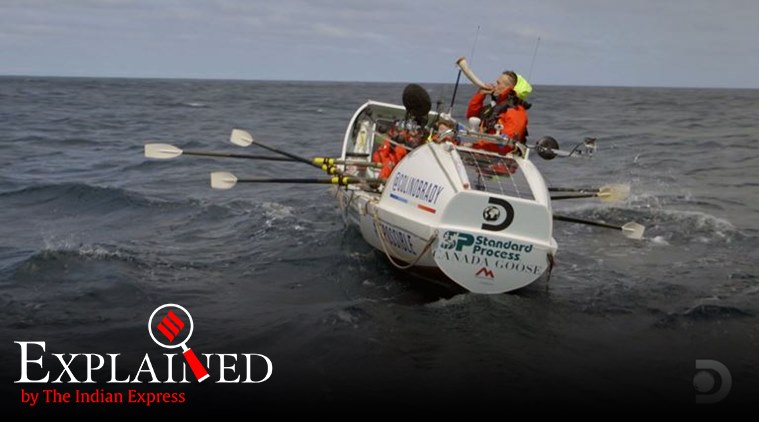Explained: What is The Impossible Row, in which 6 men crossed the Drake Passage
As per the Guinness World Records, the row represents, among other firsts, the first row on the Southern Ocean, the first row across the Drake Passage and the first row to the Antarctic continent.
 Icelandic ocean rower Fiann Paul blows a horn during The Impossible Row. Others in the team were Colin O’Brady, Cameron Bellamy, Andrew Towne, Jamie Douglas-Hamilton and John Petersen. (Photo: Discovery Channel via AP)
Icelandic ocean rower Fiann Paul blows a horn during The Impossible Row. Others in the team were Colin O’Brady, Cameron Bellamy, Andrew Towne, Jamie Douglas-Hamilton and John Petersen. (Photo: Discovery Channel via AP)
In a first, six rowers from four countries on December 25 crossed the Drake Passage, in just under two weeks after pushing off from the southern tip of South America. The Passage is located between Cape Horn at the tip of South America and the Antarctic Peninsula.
The six men are Fiann Paul, Colin O’Brady, Cameron Bellamy, Andrew Towne, Jamie Douglas-Hamilton and John Petersen, who rowed for 12 days, 1 hour and 45 minutes, making it the first completely human-powered crossing of the passage.
Also Read | Explained: Why Russia Avangard missile will have US worried
On Friday, the website of Guinness World Records (GWR) said that the row and its official time was confirmed by the GWR’s ocean rowing consultants and the Ocean Rowing Society.
As per the GWR, the row represents, among other firsts, the first row on the Southern Ocean, the first row across the Drake Passage and the first row to the Antarctic continent. The team also included the youngest and the oldest person to row on the Southern Ocean.
The project was dubbed “The Impossible Row”, for which the team departed from Cape Horn in Chile on December 13 and arrived at Primavera Base on San Martin Land on the Antarctic Peninsula on December 25.
What is the Drake Passage?
The passage is named after Sir Francis Drake, who was the first Englishman to circumnavigate the globe. According to Encyclopaedia Britannica, the passage has an average depth of about 11,000 feet, with deeper regions going up to over 15,600 feet near the northern and southern boundaries.
While making their way through the passage, the team of six dodged icebergs, held their breaths as giant whales breached near their small boat, and rode building-sized waves, the Associated Press reported.
Why is it considered so treacherous?
The Drake Passage is considered one of the roughest waterways in the world because here, layers of cold seawater from the south and warm seawater from the north collide to form powerful eddies, which when combined with strong winds and storms can be treacherous for those attempting to navigate it.
Also Read | Explained: What is Accession Day, the new public holiday for Jammu and Kashmir
It is also the narrowest stretch in the Southern Ocean and spans approximately 800 km between the southern tip of South America and the northern tip of the West Antarctic Peninsula, according to the National Oceanography Centre. NASA describes the waters of the passage as “notoriously turbulent, unpredictable, and frequented by icebergs and sea ice.”
- 01
- 02
- 03
- 04
- 05






































